Arivaca
by Jane St. Clair
Arivaca feels authentic. It doesn’t have a touristy vibe. It’s not trying to be quaint but it is. Arivaca’s a real Western town that’s been there since the 1840s.
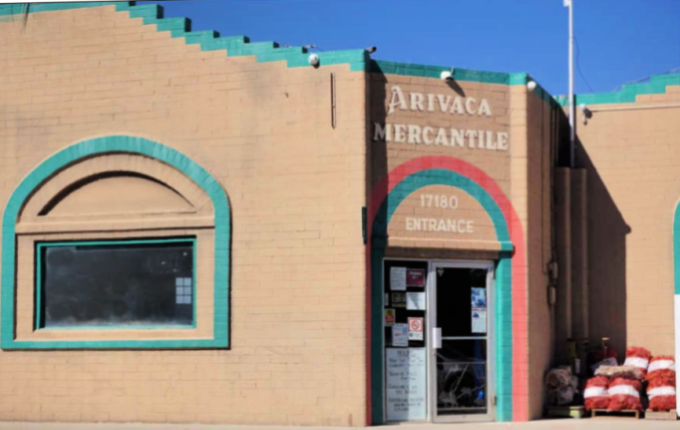
Native peoples have been living there for centuries.
 Arivaca has a really interesting bar and café, La Gitano Cantina It’s a place where people have always a good time – even today, they have music and dancing. You’re supposed to be able to find bullet holes and bloodstains on the walls. Since the bartender not only used to serve drinks but also pull teeth with his pliers, the bloodstains may be from dental work.
Arivaca has a really interesting bar and café, La Gitano Cantina It’s a place where people have always a good time – even today, they have music and dancing. You’re supposed to be able to find bullet holes and bloodstains on the walls. Since the bartender not only used to serve drinks but also pull teeth with his pliers, the bloodstains may be from dental work.
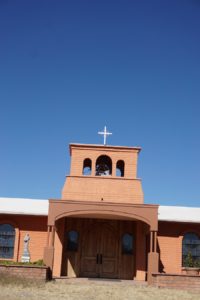 Who knows.
Who knows.
Apparently one of the owners of La Gitano loved being at his place so much that he had his ashes put into the barroom wall.
The school house dating back to 1870 is the oldest standing one in Arizona. Then there’s the general store, Arivaca Mercantile, where ranchers still get supplies. A Catholic church, the usual post office, library, and medical clinic. A few houses.
A REALLY Wild West-looking grill just outside of town.
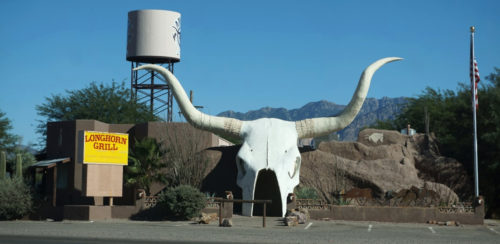
Believe it or not, the biggest problem that held back the development of Arivaca was mosquitos. After some residents got malaria in the 1930s, the State Department of Health investigated. By introducing Gambusia fish in various ponds and other water areas, the authorities got the mosquitos under control.
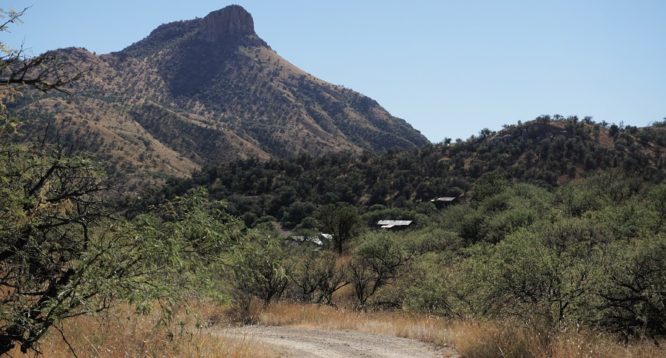
The ruins of the Ruby mine and ghost town are about six miles from Arivaca. You can visit it if the caretakers are around (they keep weird hours). However, the road to the mine is very rough and not suitable for a regular car – you’d need a truck or some such vehicle to get through patches of rocks and ravines.
What’s really interesting about this area is the scenery. It doesn’t look like your classic Arizona landscape. No castle mountains like Sedona. No jagged outlines like the Catalinas. And nothing like the forests of Flagstaff. This part of the state, very close to Mexico, has a rocky ruggedness of wilderness that’s beautiful in its own way.
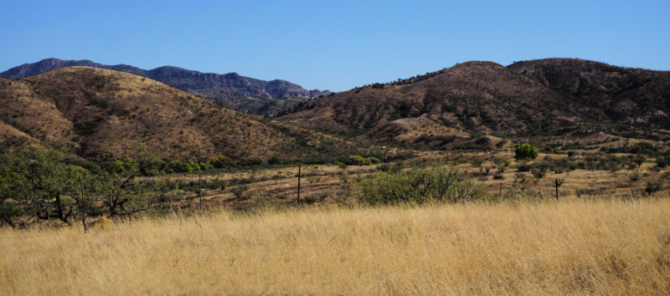
If you like exploring wilderness, you can hike in the Buenos Aires Wildlife Refuge. You may be lucky enough to spot animals and birds you probably won’t see in other parts of the state. 
The hiking’s great, the scenery’s wonderful, and Arivaca’s interesting.
Did I mention the La Gitano Cantina?
Tags: Arizona
Lake in Pinetop
by Jane St. Clair
I can’t think of anything as lovely as a late day afternoon by a lake. The way the long light slants and creates reflections. The way the color of shore flowers spill into the water in water colors.

And then there’s how night is looming, approaching, and leaving behind the last visages of daytime. It is that lazy time before wildlife finds shelter, a sensual and emotional part of the day.
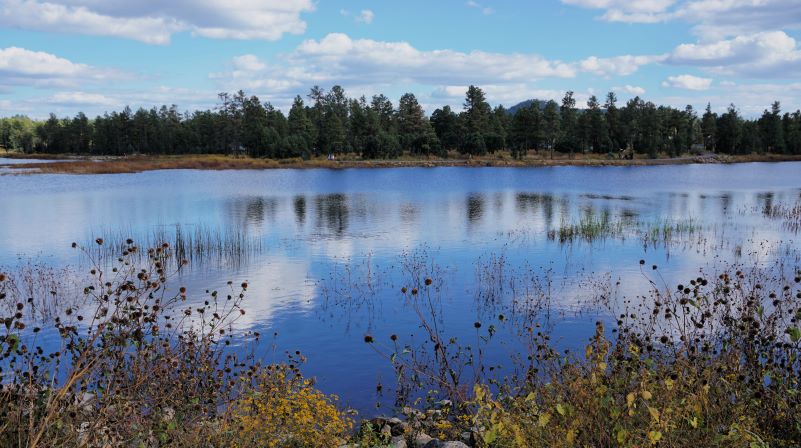
I am remembering such a late afternoon by a lake in Pinetop.
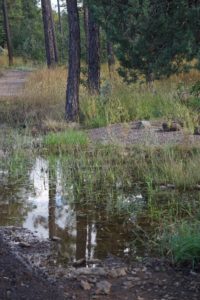
The light was so transformative that even a lowly puddle seemed magical, just as a simple weed turned into a fairy skirt.

The sparkle of the water reflections lit up this ordinary little lake in lazy little movements that only gentle currents bring, creating gentle waves tipped by light like little fish scales.
Melville wrote about going down to the sea whenever he felt like chasing funerals or stepping into traffic. He believed that the cure for “pausing before coffin houses” was going down to the sea.
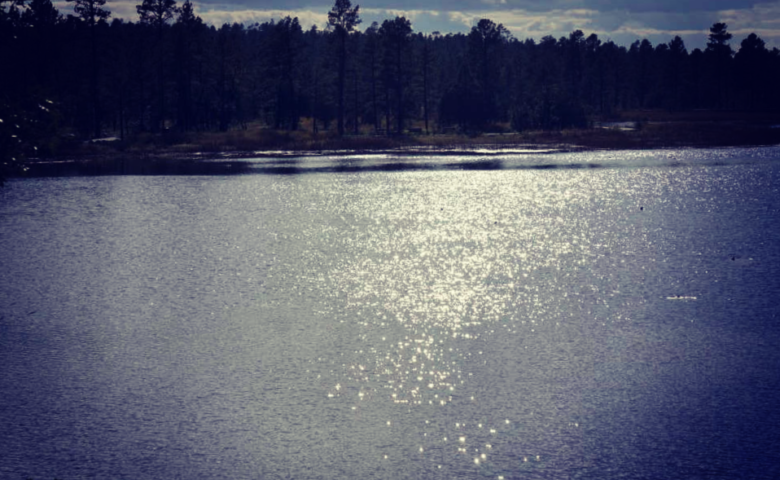
The sea reminds us, again as Melville wrote, that we have inside our souls a tiny paradise island, fully of peace and joy. Whether we stand in front of the Great Atlantic, as he did, or just a lake in Pinetop, we can travel to “that one insular Tahiti, full of peace and joy …”
I think if you have no sea, you can still find your island. Even a little lake in Pinetop will do.
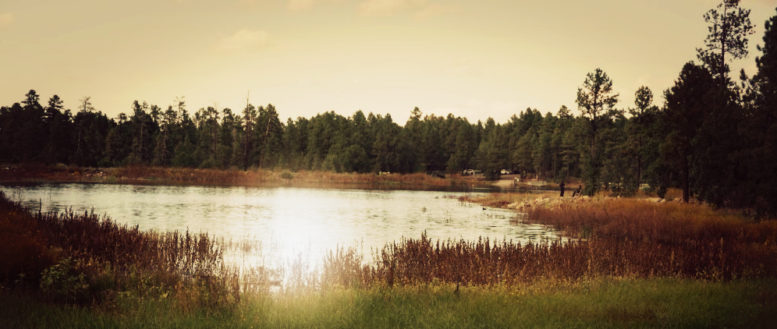
For more about visiting Pinetop, try here. For more posts about nice walks in Arizona, try here, or you could try here, or you could even try there.
Tags: Arizona
September 30th, 2021 · No Comments
Hole in the Rock Mountain
by Jane St. Clair
Hole in the Rock Mountain in Phoenix is easy to miss. The reason is two bigger attractions, the Phoenix Zoo and Phoenix Botantical Gardens, are right near Hole in the Rock Mountain.

Personally I like this little roadside attraction very much because it’s unique.
Usually when you hike in Arizona mountains, you’re on some trail that goes sideways, up or down. It’s rare that you come to a big hole with a view.
It’s like your own personal window in a big red rock. How cool is that?
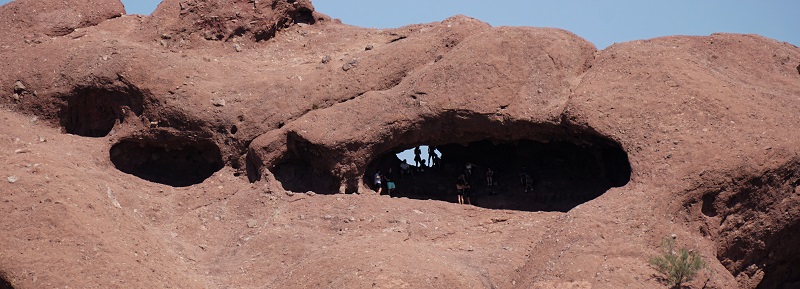
The climb to this window is pretty easy. Some manmade steps go up the trail, which is less than a third of a mile. Your award for climbing is a truly neat view of the city of Phoenix and its surrounding desert.
Especially at sunset.
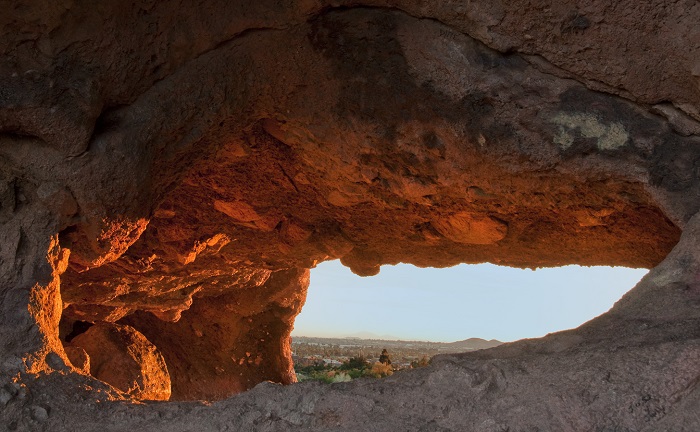
Archelogists tell us that ancient people not only enjoyed messing around in Hole in the Rock Mountain, they made it into a science project. The Hokoham figured out that a ray of sunlight coming into the Hole from its ceiling changed position based on the sun’s movements. By marking the changing light, they’d track summer and winter soltices as well as the equinoxes. Equinox happens twice a year, when night and day is the same length of time.
This mountain is probably over two million years old.
Although people like to climb for the view, I just like looking at these strange gigantic rocks. They’re bright red because they’re made of sandstone. If you look hard enough, you can see all kinds of patterns that turn into faces and other things, sometimes spooky, sometimes playful.
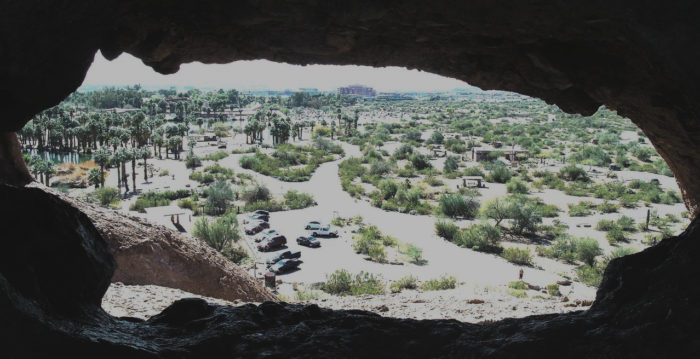
Hole in the Rock Mountain is in Pagago Park, 1500 acres for hiking and biking. That’s not counting the zoo, botanical gardens, Hall of Flame Museum, a sports complex, and a golf course.
For more posts about hiking go to Sedona: Where Castles Come From, Ramsey Canyon: A Walk in the High Country or Catalina State Park: Romero Ruins.
go to Sedona: Where Castles Come From, Ramsey Canyon: A Walk in the High Country or Catalina State Park: Romero Ruins.
Tags: Arizona
Felicity, California
by Jane St. Clair
The other day I was driving in the middle of nowhere. A very desert-y landscape near the border of Arizona, Mexico and California, unlike our beautiful and green Sonora Desert near Tucson. No sir, this was desert-y desert as in Sahara or Lawrence of Arabia.
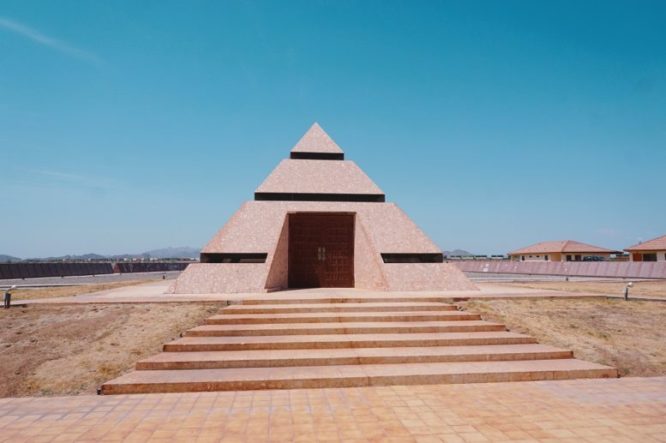
It’s the kind of spot where you see a “Last Chance Gas Station” with a skeleton sitting outside. The skeleton is wearing a Stetson and a worn-out leather vest.
That day in beautiful downtown Felicity, California, the temperature was 115 degrees. The sun was straight up, producing very bright light and rigid shadows. The long landscape was empty and barren as far as the eye could see.
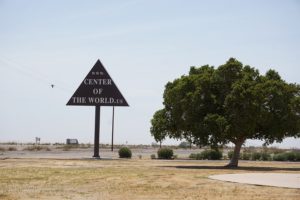
A sign read “The Center of the World.” It’s a real place, even though in this heat, you wonder if you’re imagining things.
Felicity, California has a real zip code and post office, but not very many people. It has maybe two people. The founder of the town, Andrew Istel, is mayor. In the last election, he got three votes, one from himself, one from his wife, and one from a magical dragon.
 The railroad tracks go right nearby, and there’s a strange pyramid. If you stand in the middle of the pyramid, you’re standing in the Center of the World. When attendants are around (who are not around in 115 degree heat), you can get a certificate that says you stood in the Center of the World.
The railroad tracks go right nearby, and there’s a strange pyramid. If you stand in the middle of the pyramid, you’re standing in the Center of the World. When attendants are around (who are not around in 115 degree heat), you can get a certificate that says you stood in the Center of the World.
Besides the pyramid, Felicity, California has a church and a museum with a cafeteria. Also a “stairway to nowhere” and a bowling alley. Everything was closed on that summer day.
However, I was able to walk around a very strange exhibit called “The History of the World in Granite.”
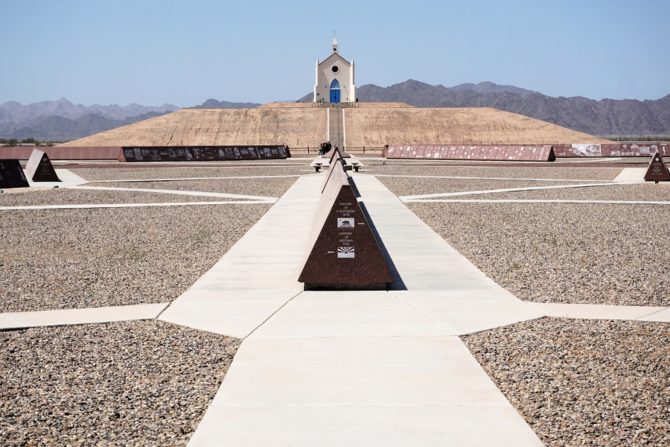
At first I thought they meant a history of granite, but no, that’s not it. It is a history of the world in granite panels with history dates and engraved pictures engraved on them. The panels look weird and creepy in the middle of the desert. They reminded me of The Monolith-thing from the movie, “2001, Space Odyssey.
Istel, who made money making parachutes, put the pyramid in his town because he thinks pyramids go along with deserts. The “Stairway to Nowhere” has bits of the Eiffel Tower in it. The “History of the World” is an on-going project.
“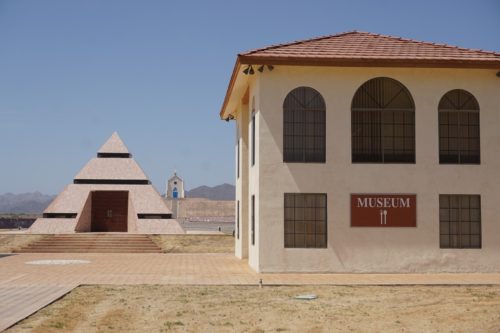
 I don’t think you need to plan your visit to Felicity, Ca. It’s probably better to just let it pop up on you. However, should you want to plan your visit, they have a website here –at the center of the world, no less.
I don’t think you need to plan your visit to Felicity, Ca. It’s probably better to just let it pop up on you. However, should you want to plan your visit, they have a website here –at the center of the world, no less.
Tags: Arizona
Brontes by
Jane St. Clair
Update! Charlotte Bronte’s little book went home to Haworth — the charity running the Bronte homestead paid a cool $1.25 million to bring it back. How wonderful is that? For more information, go here.
The most interesting thing in this auction is a tiny book that Charlotte Bronte wrote when she was a little girl. It’s part of the wonderful Glass Town game the Bronte children played every day. Glasstown was every bit as complex as Game of Thrones. And, like kids today, the Bronte children were gaming addicts. They LIVED to play Glasstown.

These six brilliant children were growing up in a creepy stone mansion on the moors of England. The family did not own the Haworth House (sounds like Harry Potter, doesn’t it?) but lived there rent-free — a perk of their father’s job as local minister.
As you can see from the above picture, the Brontes’ house connected to a church. A gloomy graveyard loomed in front of these buildings. Behind them was a rocky wilderness known as the moors. Horrific storms would rise up on the moors, which always iced over in winter.
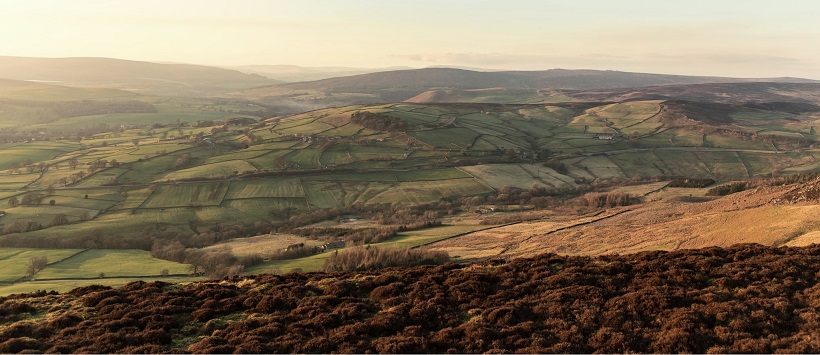
Rev. Bronte, an aloof intellectual, kept the door of his study locked all day. He was always doing something important such as writing religious books or studying great theologians.
For years the Bronte children’s mother was too sick to leave her room. When she finally died, Dad tried to remarry, or as he called it, “fulfill his domestic duty.” He proposed to ex-girlfriends, but none signed up to marry him. An old maid aunt moved in with the family to help. While she did her best, she was not good with children.

The Brontes were always broke. Since Rev. Bronte knew his children would have to make their own living some day, he sent the four older girls away to a school for the daughters of poor ministers. Charlotte later wrote about how horrible this place was in “Jane Eyre.” The oldest two Bronte girls got sick there and died, but Charlotte and Anne managed to recover.
The four remaining Bronte children grew up isolated in that creepy environment. Since Papa did not want them to mix with the children of their village, they were left on their own after their morning lessons.
One day their father came back from a business trip with a set of wooden soldiers. They became the basis of Glass Town.
The children gave each soldier a name and personality, and invented a kingdom of islands where their characters lived. For years they’d spend all day making up this elaborate game of strategy. Branwell, the only boy, adored battle plans and armies. He owned the Napoleon and Lord Wellington soldiers.
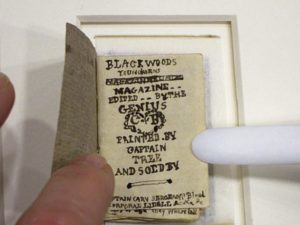
Charlotte became editor-in-chief of a tiny magazine, tiny enough for a wooden soldier to hold in his hands. She wrote her stories and editorials in such tiny handwriting that you need a magnifying glass. Branwell wrote for her magazine, but after a fight with his sister, he made up his own Glass Town newspaper named The Intelligencer.
As the years went by, the game grew more and more complex. Charlotte’s soldiers ruled the Island of Agria. Anne had Gondal, but there were other kingdoms as well. The Brontes wrote  elaborate stories about their solders’ adventures, and allowed them to constantly morph into different personalities. The children became the Four Genii, or immortal geniuses, with super-powers over the mortal soldiers.
elaborate stories about their solders’ adventures, and allowed them to constantly morph into different personalities. The children became the Four Genii, or immortal geniuses, with super-powers over the mortal soldiers.
I can just picture these brilliant, amazing creative children in that awful parsonage. Since Dad was afraid of fire, he never put up curtains but kept buckets of water everywhere. That just added to the gloom. Although the children could run wild on the moors, but the moors were creepy too.
As adults, the Brontes tried to work as tutors and governesses. But, as Charlotte wrote, they hated how their snobby employers treated them as inferior servants. None of the families showed interest in their “excellence inside,” as Charlotte put it.
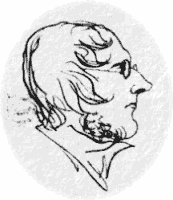 The brilliant Branwell did not last long as a tutor. He got fired after having an affair with the wife of the house, came back to Haworth and died a drunk.
The brilliant Branwell did not last long as a tutor. He got fired after having an affair with the wife of the house, came back to Haworth and died a drunk.
Branwell, Emily, and Anne died within eight months of each other. All were only about 30 years old. Only Charlotte survived to marry, but she died at age 38 in childbirth.
Yet the amazing Brontes became among the greats of English literature. Their horrendous childhood was only part of their legacy.They also left us “Jane Eyre” and “Wuthering Heights.” But to me their legacy of Glasstown is just as beautiful as their novels.
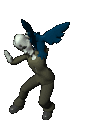 For a really cool video about Haworth, go here
For a really cool video about Haworth, go here
Tags: Brontes
Thomas Merton by
Jane St. Clair
Thomas Merton once started an entry in his diary with the wonderful statement: “Today was a perfect day.”
It turns out, however, that our monk’s idea of a perfect day was to spend it walking in the woods near his monastery in Kentucky. Nothing much happened. The most extraordinary thing that did happen was a wren hopped on his shoulder while he was writing. Then, maybe because he ignored his new little friend, the wren hopped on his writing notebook so Merton had to pay attention.
We might look back and say the perfect day is when I landed that contract, got that award, or when my sweetheart said I love you.
But to Thomas Merton, perfection lay in little things that pleased him, which is why just walking in the Kentucky woods was his idea of perfection.
Merton was so spiritual that he once had a transcendental experience looking at a vase of carnations. The flowers with their colors and crinkled edges struck him right in his soul, and he went rapturous:
…..Beauty of the sunlight falling on a tall vase of red and white carnations and green leaves on the altar of the novitiate chapel. The light and dark, the darkness of the fresh crinkled flower, light, warm and red all around the darkness. The flower is the same color as blood, but it is in no sense whatever as ‘red as blood,’ not at all. It is as red as a carnation, only that. This flower, this light, this moment, this silence = Dominus est. God is eternity. He passes. He remains.”
Looking at the flowers on the altar triggers a deep mystical experience in Merton, an experience of God and eternity. He doesn’t want to compare the color of the flowers to blood or anything else.
He just experiences the flower itself.

He writes this next:
…..We pass in and out. He passes. We remain. We are nothing. We are everything. He is in us. He has gone from us. We are here in him. He is gone from us. He is gone from us. He is not here. We are here in Him. All these things can be said, but why say them? All these things can be said, but why say them?
…..The flower is itself. The light is itself. The silence is itself. I am myself. All perhaps illusion, but no matter. For illusion is the shadow of reality, and reality is the grace and gift that underlies these lights, these colors, this silence underlies: is that true? They are simply real. They themselves are his gift…

By being present to ordinary things most of us overlook, Merton was practicing what we’d call “mindfulness.” It is a shutting down of your own ego to open up to what’s around you. To experience what is.
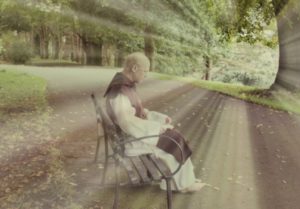
He looked at everything with an artist’s eyes, and saw beauty and God in a vase of carnations, in a drop of water on a leaf, in the way the clouds slowly part to reveal sky, in a wren resting on a book. He experienced them as gifts from God, and his writing is his gift to us.
Tags: Jane St. Clair
Arizona Sonora Desert Museum
by Jane St. Clair
The Arizona Sonora Desert Museum is three places in one. It’s hiking trails with gorgeous, panoramic views of the desert. It’s also a botanical garden, and a zoo. This makes it the Number One attraction in Tucson.

The first time I went to the Arizona Sonora Desert Museum I didn’t pay attention to the various spiders, insects and snakes. However, after I lived in Arizona a while, I became very interested in which one was which.
 If you don’t know one snake from another, you’ll mix up a nice king snake with a deadly coral. A plain brown house spider is harmless. A Brown Recluse Spider leaves a bite that turns into an ulcer that hurts for months. Little scorpions are more dangerous than big ones. Luckily, the Arizona Desert Museum has all these varieties so you can learn one from another.
If you don’t know one snake from another, you’ll mix up a nice king snake with a deadly coral. A plain brown house spider is harmless. A Brown Recluse Spider leaves a bite that turns into an ulcer that hurts for months. Little scorpions are more dangerous than big ones. Luckily, the Arizona Desert Museum has all these varieties so you can learn one from another.
Besides reptiles and insects, you also get to see all kinds of desert animals at this outdoor museum. Coyote, big horn sheep, elk deer and desert turtles all have nice habitats there. You’ll see animals you won’t see anywhere else, like ravens and javelina.
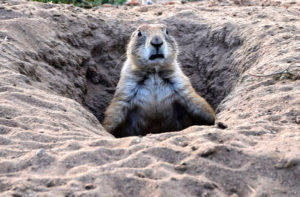 I like the prairie dog village with their funny little heads popping up and down out of their holes.
I like the prairie dog village with their funny little heads popping up and down out of their holes.
The museum has a great exhibit about animals that live underground to escape the terrible summer heat. You go into this dark tunnel and then you can peep at them in their burrows. Most of them, like kit foxes and kangaroo rats, sleep all day.
This being the American Southwest, there’s a big indoor exhibit on the geology of the mountains here – how they formed, how the desert itself formed after once being a gigantic sea, and what things looked like here millions of years ago.

The indoor exhibits like the geology and reptile house are really nice in summer because they are cool inside. There’s also an amazing hummingbird exhibit, as well as an aviary.
As you walk around the Arizona-Sonora Desert Museum, you will love to take in the beautiful, panoramic overlooks of the desert. These alone are worth the price of admission.

My favorite part of the museum is a trail that shows you how the land,
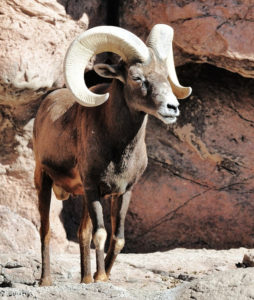 plants and animals change as you climb up a local mountain. At the bottom is the desert, but as you make your way up, you come across ponderosa, pine forest, and many other ecosystems. This is what makes the Tucson area one of the most biologically diverse in the planet.
plants and animals change as you climb up a local mountain. At the bottom is the desert, but as you make your way up, you come across ponderosa, pine forest, and many other ecosystems. This is what makes the Tucson area one of the most biologically diverse in the planet.
Plan on spending an entire day at the Arizona-Sonora Desert Museum. Besides the natural beauty of the place, you’ll love their fancy restaurants and awesome gift store.
Arizona Sonora Desert Museum has a terrific website not only with information on hours and tickets, but just about the desert in general.
Go here.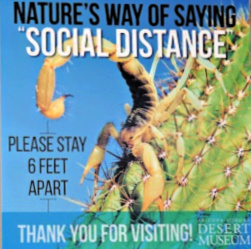
Tags: Arizona
Tarantulas by Jane St. Clair
When you live in the Arizona desert, you’re sure to see tarantulas. These are big hairy spiders that are quite scary when you come upon them.

I once accidentally brought one in the house. He must have jumped into my laundry basket when I was bringing in clothes from outside.
 He crawled across the living room, looking like something out of a James Bond movie. His Dracula fangs were particularly scary.
He crawled across the living room, looking like something out of a James Bond movie. His Dracula fangs were particularly scary.
However, unlike spiders in horror movies, this tarantula didn’t chase anyone. Instead, he just ran away from us the way a mouse would. Even if he had bit someone, it would have ended up being more like a bee bite than a whack from a poisonous snake.
The thing is Hollywood makes people scared of tarantulas. Besides “Dr. No,” there’s a horror movie about hordes of tarantulas attacking a California town, and another one called “Tarantula!,” about a spider the size of the Chrysler Building. My favorite is “The Incredible Shrinking Man,” about a tiny person who uses a toothpick/sword to battle a huge spider.
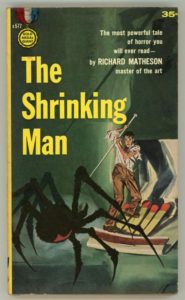
Even though tarantulas are big hairy spiders, they’re actually very sweet, docile animals For all we know, they may even be kindhearted.
Tarantulas are hunters even though they move slowly. They catch their food by sneaking up on prey and poisoning it. I guess their webs are just decorative.
If they get hurt while hunting, tarantulas can grow new legs if they have to.

Besides biting people, a tarantula will protect himself by throwing hairs at you from his belly. This experience can be painful. Also it leaves the spider with a bald spot on his tummy. By the way, tarantulas have very bad eyes, and use their hairs as sense organs
In a terrible example of sexual inequality, female tarantulas live 30 years but males only seven.
I hadn’t been in Arizona very long when I heard about Tarantula Hawks. I assumed they were big birds that went after big spiders, but no, that is wrong. Tarantula Hawks are quite disgusting insects who lay their eggs in the bellies of tarantula spiders.

When the baby tarantula hawks hatch, they feed on the poor spider. There, I’ve just ruined your day for you.
Some people are crazy about tarantulas and keep them as pets. There is actually an American Tarantula Society dedicated to these spiders, as well there should be. However, this makes you wonder if they’ve seen any movies.

Tags: Tarantulas
Old Tucson Closed
by Jane St. Clair
Old Tucson closed because of Covid, and, as the French say, quelle tragique!
Movie companies made over 400 movies and TV shows at Old Tucson’s studio since it opened in 1939. This means that so much of the power and myth of the Old West came out of this historical place.
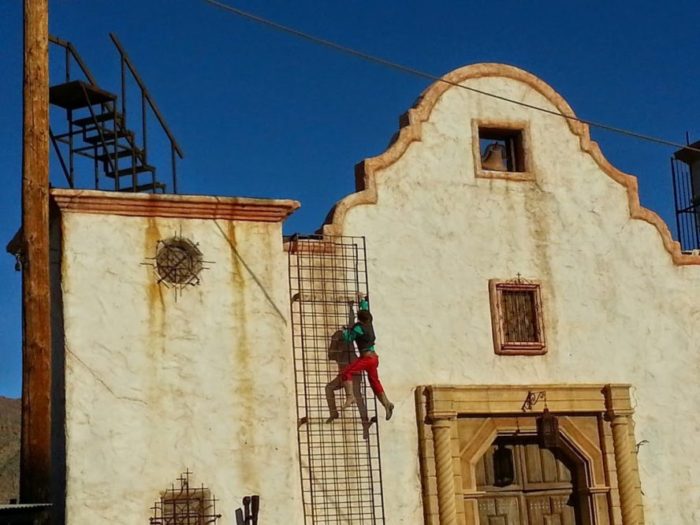 Some TV classics like Gunsmoke, Bonanza, Have Gun Will Travel, and Little House on the Prairie shaped the way Americans picture the frontier, and the cowboys and cowgirls who built it. Likewise, classic movies like Tombstone and How the West Was Won, also filmed there.
Some TV classics like Gunsmoke, Bonanza, Have Gun Will Travel, and Little House on the Prairie shaped the way Americans picture the frontier, and the cowboys and cowgirls who built it. Likewise, classic movies like Tombstone and How the West Was Won, also filmed there.
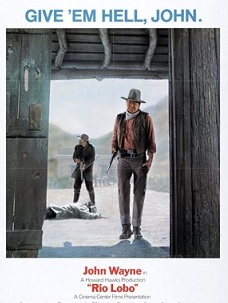
However, even non-western films came out of Old Tucson, like Tin Cup, Revenge of the Nerds, and Death Wish.
Before Old Tucson closed, it was not only a place to film movies, it was a tourist attraction. For a long time it was second only to the Grand Canyon as the most visited attractions in Arizona.
You could wander around the saloons and little shops, eat at Western-themed restaurants, and ride the train around the park. Every time the train went around the park, however, robbers would attack it every time.
Or you could also ride a stagecoach (bumpy).
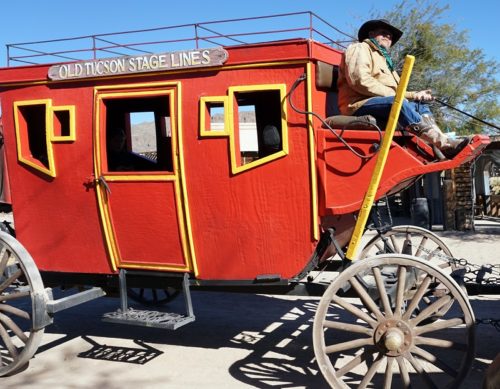
You’d learn a lot about making western movies. Stunt cowboys would demonstrate how they’d make a fist fight look real or how they could safely fall from a building. You could wander inside the Old Tucson main studio, and see costumes, guns, and other props from great western films.
But I wouldn’t call it an educational spot. It was too much fun for that, especially at Halloween.
On April 24, 1995, Old Tucson had a massive fire that took out the main studio and three-fourths of its buildings. Some were just flimsy one-dimensional backdrops.
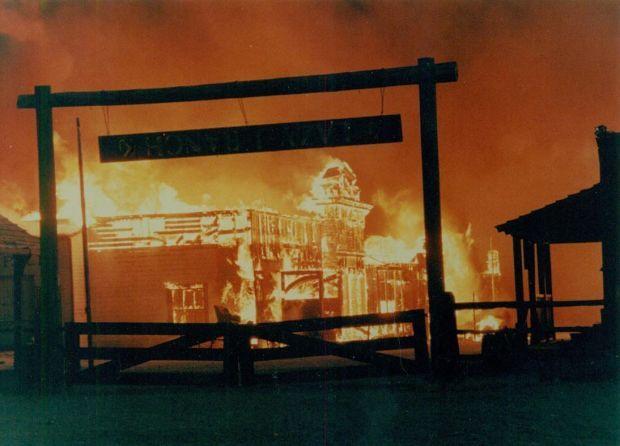
Yet it was a true disaster for film historians, because the fire destroyed costumes, piles of photos, rare behind-the-scenes footage, and even a priceless doll collection. Parts of the Reno, the park’s locomotive, melted. Old Tucson closed, and did not reopen until January 1997.
On September 14, 2020, because of Covid, Pima County took over Old Tucson. Pima County is working on a plan for the park’s future.
The park’s future cannot come too soon.

 For a description of Old Tucson before Covid, go here. For a list of movies filmed at Old Tucson, and a list of movies that used her locomotive, go here here.
For a description of Old Tucson before Covid, go here. For a list of movies filmed at Old Tucson, and a list of movies that used her locomotive, go here here.
Tags: Old Tucson
Big Horn Sheep
by Jane St. Clair
I love big horn sheep. I believe every fantastic thing that anyone tells me about them because they’re that amazing.
Once a guide on a tour at Sabino Canyon told our group that big horn sheep have suckers on the bottoms of their feet, which is why they can climb straight up rocks. I believed him.

Because it looks like they have suckers on the bottom of their feet –or at least some kind of moon-walker thing—when you watch big horn sheep climb up the side of a mountain.
They look cool when they’re up so high. Big horn sheep definitely aren’t afraid of heights.
And then there’s those horns. Those horns are to die for. The horns can weigh 40 pounds on an animal that weighs about 300. How amazing is that? And look at the way the horns twist around the ram’s face, like beautiful coils on Princess Lelia. Gorgeous!

Here in Tucson, Arizona, government officials in charge of wildlife tried to reintroduce big horn sheep into Catalina State Park. Hundreds of them once roamed the mountains here,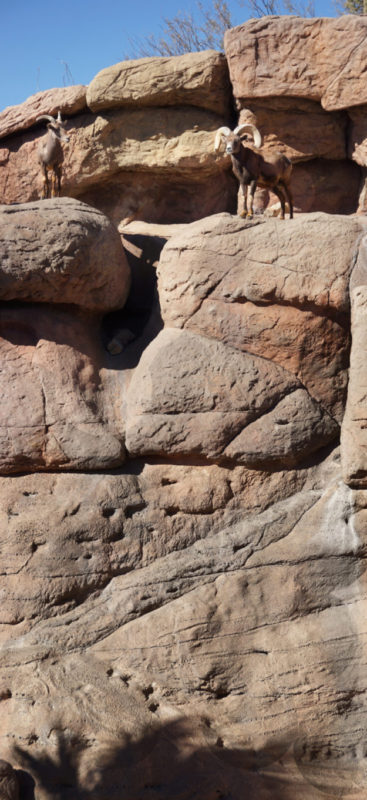
but now their numbers have dropped. It’s not bad enough to put them on the endangered species lists, but enough that you never see them where people used to see them a lot.
About seven years ago, the Wildlife Service started dropping big horn sheep into Catalina Park. The animals had computer chips in them so the rangers could trace their every movement. Sadly, as biologists monitored their screens for signs of movement and life, they realized that most of the new big horn sheep were dying. It is true some died naturally through accidents and such, because they were not used to their new home.
Yet the main reason sheep were flat-lining was that they had become mountain lion food.
Something had to be done about hungry mountain lions.
Almost immediately, people around here divided into Team Lion and Team Big Horn Sheep. Team Sheep wanted everything possible done to save the sheep. Team Lion argued lions were just doing what lions got to do, so it’s not fair to shoot them to protect another species.

In the end, they reached a compromise. The Wildlife Service took new precautions with the second round of sheep they introduced into the park in the hope of making easier for them to survive, but they did shoot a few lions.
In 2018, about 65 sheep were living in Catalina State Park, and maybe 5,000 in the state of Arizona. So, with a little luck, the numbers will grow even bigger.
How lucky can we get?
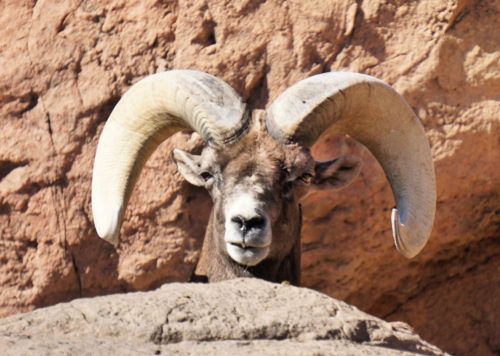
Here’s looking at you, babe.
* * * * * * * * *

Read Jane’s short story, “The Year of the Tomato” in The Bangalore Review.
Tags: Tucson

 Arivaca has a really interesting bar and café, La Gitano Cantina It’s a place where people have always a good time – even today, they have music and dancing. You’re supposed to be able to find bullet holes and bloodstains on the walls. Since the bartender not only used to serve drinks but also pull teeth with his pliers, the bloodstains may be from dental work.
Arivaca has a really interesting bar and café, La Gitano Cantina It’s a place where people have always a good time – even today, they have music and dancing. You’re supposed to be able to find bullet holes and bloodstains on the walls. Since the bartender not only used to serve drinks but also pull teeth with his pliers, the bloodstains may be from dental work. Who knows.
Who knows.















 go to
go to 

 The railroad tracks go right nearby, and there’s a strange pyramid. If you stand in the middle of the pyramid, you’re standing in the Center of the World. When attendants are around (who are not around in 115 degree heat), you can get a certificate that says you stood in the Center of the World.
The railroad tracks go right nearby, and there’s a strange pyramid. If you stand in the middle of the pyramid, you’re standing in the Center of the World. When attendants are around (who are not around in 115 degree heat), you can get a certificate that says you stood in the Center of the World.

 I don’t think you need to plan your visit to Felicity, Ca. It’s probably better to just let it pop up on you. However, should you want to plan your visit, they have a website
I don’t think you need to plan your visit to Felicity, Ca. It’s probably better to just let it pop up on you. However, should you want to plan your visit, they have a website 



 elaborate stories about their solders’ adventures, and allowed them to constantly morph into different personalities. The children became the Four Genii, or immortal geniuses, with super-powers over the mortal soldiers.
elaborate stories about their solders’ adventures, and allowed them to constantly morph into different personalities. The children became the Four Genii, or immortal geniuses, with super-powers over the mortal soldiers. The brilliant Branwell did not last long as a tutor. He got fired after having an affair with the wife of the house, came back to Haworth and died a drunk.
The brilliant Branwell did not last long as a tutor. He got fired after having an affair with the wife of the house, came back to Haworth and died a drunk. For a really cool video about Haworth, go
For a really cool video about Haworth, go 
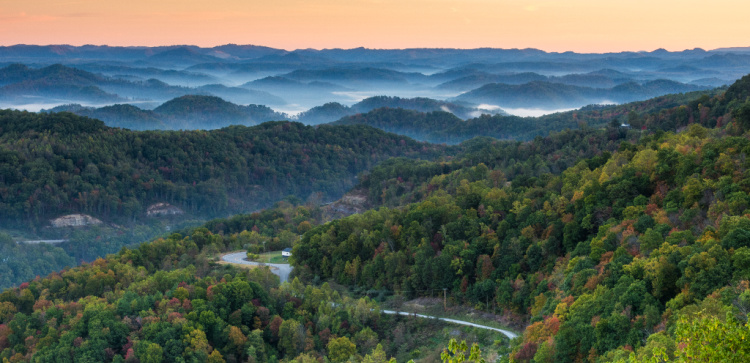





 If you don’t know one snake from another, you’ll mix up a nice king snake with a deadly coral. A plain brown house spider is harmless. A Brown Recluse Spider leaves a bite that turns into an ulcer that hurts for months. Little scorpions are more dangerous than big ones. Luckily, the Arizona Desert Museum has all these varieties so you can learn one from another.
If you don’t know one snake from another, you’ll mix up a nice king snake with a deadly coral. A plain brown house spider is harmless. A Brown Recluse Spider leaves a bite that turns into an ulcer that hurts for months. Little scorpions are more dangerous than big ones. Luckily, the Arizona Desert Museum has all these varieties so you can learn one from another. I like the prairie dog village with their funny little heads popping up and down out of their holes.
I like the prairie dog village with their funny little heads popping up and down out of their holes. 

 plants and animals change as you climb up a local mountain. At the bottom is the desert, but as you make your way up, you come across ponderosa, pine forest, and many other ecosystems. This is what makes the Tucson area one of the most biologically diverse in the planet.
plants and animals change as you climb up a local mountain. At the bottom is the desert, but as you make your way up, you come across ponderosa, pine forest, and many other ecosystems. This is what makes the Tucson area one of the most biologically diverse in the planet.

 He crawled across the living room, looking like something out of a James Bond movie. His Dracula fangs were particularly scary.
He crawled across the living room, looking like something out of a James Bond movie. His Dracula fangs were particularly scary. 



 Some TV classics like Gunsmoke, Bonanza, Have Gun Will Travel, and Little House on the Prairie shaped the way Americans picture the frontier, and the cowboys and cowgirls who built it. Likewise, classic movies like Tombstone and How the West Was Won, also filmed there.
Some TV classics like Gunsmoke, Bonanza, Have Gun Will Travel, and Little House on the Prairie shaped the way Americans picture the frontier, and the cowboys and cowgirls who built it. Likewise, classic movies like Tombstone and How the West Was Won, also filmed there.



 For a description of Old Tucson before Covid, go
For a description of Old Tucson before Covid, go 




